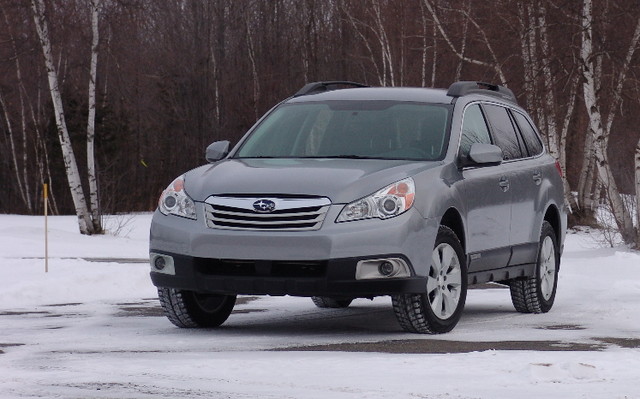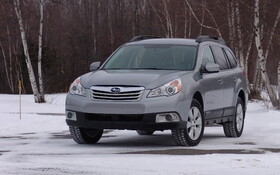2010 Subaru Outback: Perfectly logical

| Strong points |
|
|---|---|
| Weak points |
|
In 1982, forgoing his usual penchant for American cars, my father bought himself a brand new Subaru GL sedan...in pale yellow. It had a 1.8-litre, 71 horsepower engine, front-wheel drive and a five-speed manual transmission with a clutch hard enough to sculpt your thight after only a couple of starts and stops.
Almost 30 years later, Subaru has come an awfully long way. Once little cars that rusted as soon as you looked at them, Subaru models have become models of civility and gentleness. Note that ALL cars are infinitely more subtle, and Subaru is just following the trend. And today, in many ways, this little Japanese brand has surpassed its rivals.
When Subaru completely overhauled is Legacy/Outback duo last fall, it seized the opportunity to simplify its line. Good-bye Legacy wagon. From now on, the Legacy is an intermediate sedan, while the Outback is available only as a wagon (although it’s more like a crossover). Last October, two distinguished members of www.carguideweb.com, misters Morin and Raymond, went from Montreal to Niagara-On-the-Lake and back in an Outback. Aside from the fact that I found my partner less and less brilliant as the trip went on, I was struck more than anything by the car’s fuel consumption. In fact, driving at an average speed of 115 km/hr (a little faster with Raymond at the wheel), we had an average fuel consumption of 7.8 L/100 km. A few weeks ago, we reconnected with the Outback PZEV.
PZEV
To do its part for the environment, Subaru is offering a PZEV version of its Legacy, Outback and Forester. PZEV stands for “Partial Zero Emission Vehicle” and the technology comes only with the four-cylinder, 2.5-litre engine. First of all, note that this technology is extremely smooth for the driver and doesn’t help lower fuel consumption. To reduce emissions as much as possible, Subaru overhauled the programming of the Engine Command Module (ECM), the air intake system, the fuel injectors and the catalytic converter. PZEV technology is offered only with the base model, which some people may consider a drawback.
The 2.5-litre engine features 170 hp and an equal amount of pounds per foot of torque. Although the car weighs 1,591 kg (3,507 pounds), it goes 0-100 km/hr in 10.8 seconds, which isn’t too bad at all. The Outback also offers a six-cylinder, 3.6-litre engine that features 256 horsepower and 247 lbs-ft of torque. That will move you a little faster, but it uses a little more fuel as well. In both cases, they are flat engines. The 2.5 can tow up to 1,227 kg (2,705 pounds) while the 3.6 tows up to 1,363 kg (3,000 pounds).
Our Outback had a continuously variable transmission (CVT). Not too long ago, I used to gag just going near a car equipped with that type of gearbox, but I must admit that the one in the Outback (and the Legacy, of course) is so spot-on that it’s winning me over again. Regardless of the version, you can you can change the virtual gears using the shifters behind the steering wheel. You don’t even have to move the stick shift! So, if the need for power suddenly arises, to overtake for example, all you have to do to downshift is pull the left shifter toward you. At 100 km/hr, it helps the engine rev at only 1,800 rpm and at about 2,100 at 120 km/hr. Subaru also offers a six-speed manual, but we recommend the CVT, given that the manual consumes more gas and it will be harder to sell later on.
Oh-so practical
Whether you like the lines of a wagon or not, you have to admit that for practicality, it’s tough to beat. For example, the Outback has a loading capacity between 972 and 2,019 litres, depending on whether the rear bench is up or down. That’s huge, although it’s a smidge less than the Volvo XC70. Then again, it’s a smidge more than the Toyota Venza. After a week during which we moved just about anything that can be moved, we can confirm that the low loading height is very practical (especially when you have to transport a television). However, a rubber strip on the top of the bumper would be a good addition to avoid scratches. Under the floor, there are two very practical storage bins, and I almost fell to my knees in tears when I discovered that my prayers had finally been answered: Someone at Subaru thought of creating a space deep enough to store a jug of windshield washer!
The passenger compartment is comfortable, but a little more soundproofing material wouldn’t hurt, especially for accelerations. On a trip to the edge of Ontario, I found the front seats a little hard over time, but perhaps my growing impatience was to blame... Accessing the backseats is easy since the doors open wide and the leg and head room is adequate. Only the overly hard and straight middle seat gets a failing grade. As for the all-around visibility, we have no complaints.
No surprise
There are no surprises when it comes to driving the Outback PZEV. The suspensions are unquestionably comfort-oriented and I found them a little less firm than on the Legacy PZEV that I test drove a few weeks earlier. The steering is reasonably lively and precise and we discovered a little bit of a roll when we took a corner a little too fast. At the same time, we also discovered that the driver’s seat could do with better lateral support. An emergency stop revealed that the brake pedal was a little soft, but what’s more troubling is the fact that after a complete stop, the transmission takes a little time before re-engaging. However, by downshifting using the shifters while braking, this problem can be avoided. Note that this is easier said than done in a real emergency...
Logical and attractive
Although a wagon with all-wheel drive at an affordable price is a very useful and logical vehicle, there are very few of them on the market. Sure, there’s the Volvo XC70, Volkswagen Passat and Toyota Venza, but what else?... The Ford Edge can be put in this category along with the new Honda Accord Crosstour, even though this one doesn’t have much of a trunk. Whatever the case may be, like the Volvo XC70, the Outback is part of a special category that has had loyal supporters for ages, regulars who swear by the difference. But this new generation that better meets American needs (read: ours) may disappoint some of these believers... and better satisfy a lot of others!











